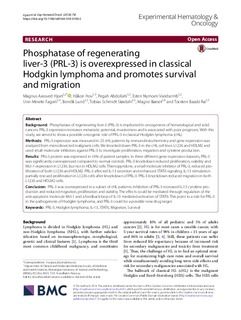| dc.contributor.author | Hjort, Magnus Aasved | |
| dc.contributor.author | Hov, Håkon | |
| dc.contributor.author | Abdollahi, Pegah | |
| dc.contributor.author | Vandsemb, Esten | |
| dc.contributor.author | Fagerli, Unn-Merete | |
| dc.contributor.author | Lund, Bendik | |
| dc.contributor.author | Slørdahl, Tobias Schmidt | |
| dc.contributor.author | Børset, Magne | |
| dc.contributor.author | Rø, Torstein Baade | |
| dc.date.accessioned | 2018-05-11T07:37:47Z | |
| dc.date.available | 2018-05-11T07:37:47Z | |
| dc.date.created | 2018-05-08T20:48:25Z | |
| dc.date.issued | 2018 | |
| dc.identifier.issn | 2162-3619 | |
| dc.identifier.uri | http://hdl.handle.net/11250/2497869 | |
| dc.description.abstract | Background
Phosphatase of regenerating liver-3 (PRL-3) is implicated in oncogenesis of hematological and solid cancers. PRL-3 expression increases metastatic potential, invasiveness and is associated with poor prognosis. With this study, we aimed to show a possible oncogenic role of PRL-3 in classical Hodgkin lymphoma (cHL).
Methods
PRL-3 expression was measured in 25 cHL patients by immunohistochemistry and gene expression was analyzed from microdissected malignant cells. We knocked down PRL-3 in the cHL cell lines L1236 and HDLM2 and used small molecular inhibitors against PRL-3 to investigate proliferation, migration and cytokine production.
Results
PRL-3 protein was expressed in 16% of patient samples. In three different gene expression datasets, PRL-3 was significantly overexpressed compared to normal controls. PRL-3 knockdown reduced proliferation, viability and Mcl-1 expression in L1236, but not in HDLM2 cells. Thienopyridone, a small molecule inhibitor of PRL-3, reduced proliferation of both L1236 and HDLM2. PRL-3 affected IL-13 secretion and enhanced STAT6 signaling. IL-13 stimulation partially rescued proliferation in L1236 cells after knockdown of PRL-3. PRL-3 knockdown reduced migration in both L1236 and HDLM2 cells.
Conclusion
PRL-3 was overexpressed in a subset of cHL patients. Inhibition of PRL-3 increased IL-13 cytokine production and reduced migration, proliferation and viability. The effects could be mediated through regulation of the anti-apoptotic molecule Mcl-1 and a feedback loop of IL-13 mediated activation of STAT6. This point to a role for PRL-3 in the pathogenesis of Hodgkin lymphoma, and PRL-3 could be a possible new drug target. | nb_NO |
| dc.language.iso | eng | nb_NO |
| dc.publisher | BioMed Central | nb_NO |
| dc.rights | Navngivelse 4.0 Internasjonal | * |
| dc.rights.uri | http://creativecommons.org/licenses/by/4.0/deed.no | * |
| dc.title | Phosphatase of regenerating liver-3 (PRL-3) is overexpressed in classical Hodgkin lymphoma and promotes survival and migration | nb_NO |
| dc.type | Journal article | nb_NO |
| dc.type | Peer reviewed | nb_NO |
| dc.description.version | publishedVersion | nb_NO |
| dc.source.volume | 7 | nb_NO |
| dc.source.journal | Experimental hematology and oncology | nb_NO |
| dc.source.issue | 8 | nb_NO |
| dc.identifier.doi | 10.1186/s40164-018-0100-2 | |
| dc.identifier.cristin | 1584216 | |
| dc.description.localcode | © The Author(s) 2018. This article is distributed under the terms of the Creative Commons Attribution 4.0 International License (http://creativecommons.org/licenses/by/4.0/ | nb_NO |
| cristin.unitcode | 194,65,15,0 | |
| cristin.unitcode | 194,65,1,0 | |
| cristin.unitname | Institutt for klinisk og molekylær medisin | |
| cristin.unitname | MH fakultetsadministrasjon | |
| cristin.ispublished | true | |
| cristin.fulltext | original | |
| cristin.qualitycode | 1 | |

